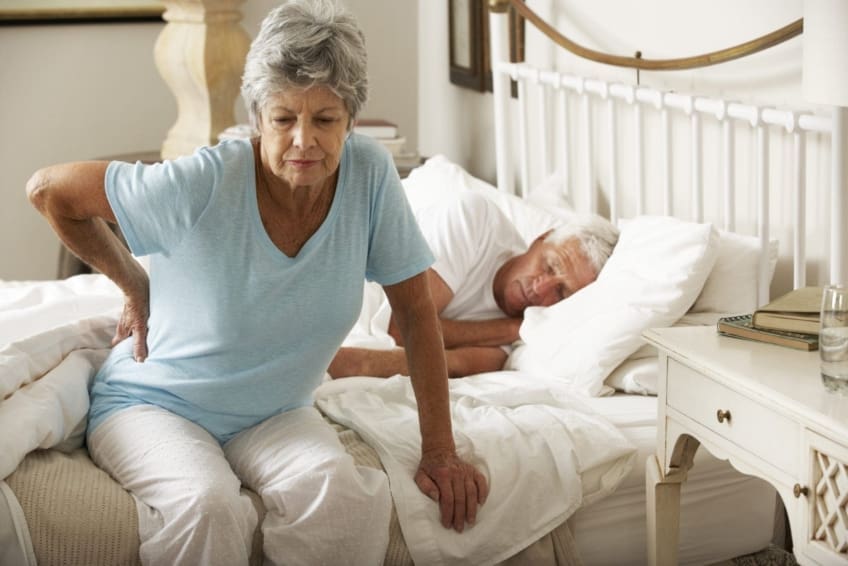
Arthritis is inflammation (swelling) of the joints. It causes pain and often limits movement of the affected joints. There are many kinds of arthritis. Osteoarthritis is the most common kind.
What is osteoarthritis?
Osteoarthritis is sometimes called degenerative joint disease or “wear-and-tear” arthritis. It can affect any joint in your body. It most often happens in the hands, hips, knees, and spine. It causes the cushion layer between your bones (called the cartilage) to wear away. This happens slowly and usually gets worse over time.
There are some factors that can increase your risk of developing osteoarthritis, including:
- Being overweight or having obesity. Excess weight can make arthritis worse in the weight-bearing joints like knees, hips, and spine.
- Having a joint injury. Joints that have been injured, damaged, or had steroid injections are more likely to develop osteoarthritis.
- Repeating movements at work. People who have jobs that require the same movement over and over (like painting or lifting) are at higher risk.
- Being older. Osteoarthritis is more common in older people because they have been using their joints longer.
- Being a female. Women are more likely to develop osteoarthritis than men, especially after age 50.


If you’re having joint pain, tell your family doctor. Treating early can help prevent or reduce lifelong disability. Read More
Symptoms of osteoarthritis
The most common symptoms of osteoarthritis include:
- Pain or aching in the joint
- Stiffness in the joint, especially after not moving, such as after sleeping or sitting
- Swelling and tenderness in the joint
- A clicking noise when moving the joint
- A decreased range of motion in the joint
What causes osteoarthritis?
The exact cause of osteoarthritis isn’t known. It may be hereditary, which means it runs in families. People who play sports may get it because sports can be hard on joints. However, in most people, it seems to be related to the wear and tear put on joints over the years.
Normally, a smooth layer of cartilage acts as a pad between the bones of a joint. Cartilage helps the joint move easily and comfortably. In some people, the cartilage thins as the joints are used. This is the start of osteoarthritis. Over time, the cartilage wears away and the bones may rub against each other. The rubbing causes pain, swelling, and decreased motion of the joint.
Bones may even start to grow too thick on the ends where they meet to make a joint. Bits of cartilage may loosen and get in the way of movement. This also can cause pain, swelling, and stiffness.
How is osteoarthritis diagnosed?
Your doctor will ask you questions about your pain. They will probably ask you if your joint pain gets worse with activity and better with rest. Your doctor will examine you to see if you have trouble moving your joint. Your doctor may order an X-ray or an MRI of the joint that’s causing problems to see what’s causing the pain. Blood tests can help rule out other forms of arthritis.
Can osteoarthritis be prevented or avoided?
There’s not much you can do to avoid getting osteoarthritis as you age. However, the following may help:
- Try to not overuse your joints.
- Try to avoid jobs or activities that require repetitive movement.
- Maintain a healthy body weight.
- Do strength-training exercises to keep the muscles around your joints strong. This is especially important for weight-bearing joints, such as the hips, knees, and ankles.
Osteoarthritis treatment
There is no cure for osteoarthritis. It will probably get worse over time. But the right plan can help you stay active, protect your joints from damage, limit injury, and control pain. Your doctor will help you create a plan that is right for you. They will treat you with a combination of therapies.
Physical activity
It’s important to stay as active as possible. When joints hurt, people tend not to use them as much. Then the muscles get weak. This can cause the joint to work less effectively. That can make it harder to get around. This causes more pain, and the cycle begins again. Talk to your doctor about ways to control your pain so that you can stay active and avoid this problem.
Exercise keeps your muscles strong and helps you stay flexible. Exercises that don’t strain your joints are best. To avoid pain and injury, choose exercises that can be done in small amounts with rest time in between. Dancing, weight-lifting, swimming, and bike-riding are good exercises for people who have arthritis. Avoid activities that make your pain worse.
Your doctor may also prescribe physical therapy. This usually includes muscle-strengthening exercises that can help your joints work better and reduce arthritis pain.
Medicine
Your doctor will probably recommend taking over-the-counter medicines to manage your pain. These are medicines you can buy without a doctor’s prescription. Nonsteroidal anti-inflammatory drugs (NSAIDs) reduce inflammation and relieve pain. They include aspirin, ibuprofen (one brand name: Advil), and naproxen (one brand name: Aleve). Other pain relievers may help you feel better, such as acetaminophen (one brand name: Tylenol).
Your doctor can also prescribe medicine for you. This could be prescription pain relievers or prescription NSAIDs.
Medicine should be used wisely. You only need the amount that makes you feel good enough to keep moving. Using too much medicine may increase the risk of side effects.
Special devices
Special supportive devices can help people who have arthritis stay independent. These devices help protect your joints and keep you moving. Devices can include canes, crutches, and walkers. Talk to your doctor if you think a special device may help your arthritis.
Other treatments
Sometimes osteoarthritis becomes severe. It can cause severe joint pain, swelling, and stiffness. When other therapies haven’t worked, your doctor may give you a shot in your joint. The shot could contain pain medicine. This can stop the pain for days to weeks. Adding another medicine (called a corticosteroid) may keep the pain and inflammation away longer.
If this doesn’t help enough, your doctor may talk to you about hyaluronic acid injections. Your joints already contain hyaluronic acid. If you have osteoarthritis, that acid gets thinner. When this happens, there isn’t enough hyaluronic acid to protect the joint. These shots put more hyaluronic acid into your joint to help protect it. These injections are usually only used for osteoarthritis in the knee. These injections help some people, but not everyone. And some research has shown that they don’t work. The American Academy of Orthopaedic Surgeons doesn’t recommend using hyaluronic acid for osteoarthritis of the knee.
Talk to your doctor about injections to see if they would be a good choice for you.
What about surgery?
Sometimes osteoarthritis is so severe that surgery is required to relieve the symptoms. There are many types of surgery for osteoarthritis. The type of surgery you may have depends on several factors. These include your age, your activity level, which joint is affected, and how bad the damage is. Talk to your doctor to learn which surgery will be best for you.
Surgical options include:
- Arthroscopy. With a tiny camera and special instruments, the surgeon can see how badly the joint has been damaged. They can remove damaged parts of the joint and clean the joint to remove any loose parts that may be causing you pain. It may provide temporary relief from pain or delay the need for other surgeries.
- Osteotomy. This surgery repositions or reshapes the bones in your joint where osteoarthritis has caused damage. It can shift your weight away from an area that has been damaged or correct misalignment in a joint. This procedure restores movement in your joint and relieves the pain. People who have an osteotomy may need joint replacement surgery in the future.
- Arthroplasty. This also is known as joint replacement therapy. A surgeon removes the damaged joint and replaces it with an artificial joint made from metals, plastic, and/or ceramic. All or part of the joint may be replaced. Joint replacement therapy can help put an end to your pain and improve or restore movement in your joint.
Living with osteoarthritis
There are some things you can do to help you manage your life when you have osteoarthritis. They include:
- Lose weight if you’re overweight. This can reduce stress on your joints, especially the hips and knees.
- Exercise regularly for short periods. This can also help with losing weight. Talk to your doctor about a safe exercise program for you.
- Use a cane and other special devices to protect your joints.
- Avoid overusing your joints.
- Take your medicine the way your doctor tells you to.
- Use heat and/or cold therapies to reduce joint pain or swelling.
- Consider taking nutritional supplements, such as glucosamine and chondroitin sulfate. They may help improve symptoms.
- Get support. Arthritis support groups, self-management programs, and patient education programs can help you learn about self-care and improve your outlook.
Questions for your doctor
- What kind of arthritis do I have?
- How do you know its osteoarthritis and not another kind?
- What caused it?
- What kind of treatment will be best for me?
- Do I need prescription pain medicine?
- Will my osteoarthritis get worse over time?
- Will I need surgery?
![]()
Copyright © American Academy of Family Physicians
This information provides a general overview and may not apply to everyone. Talk to your family doctor to find out if this information applies to you and to get more information on this subject.









